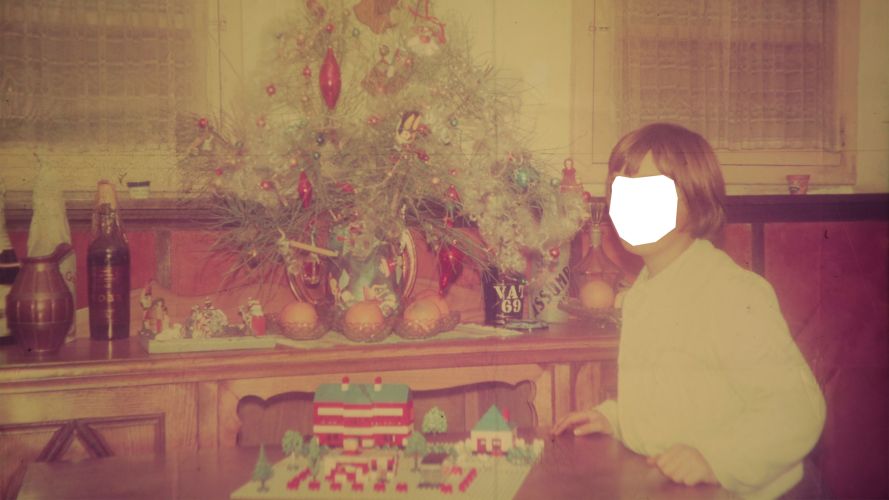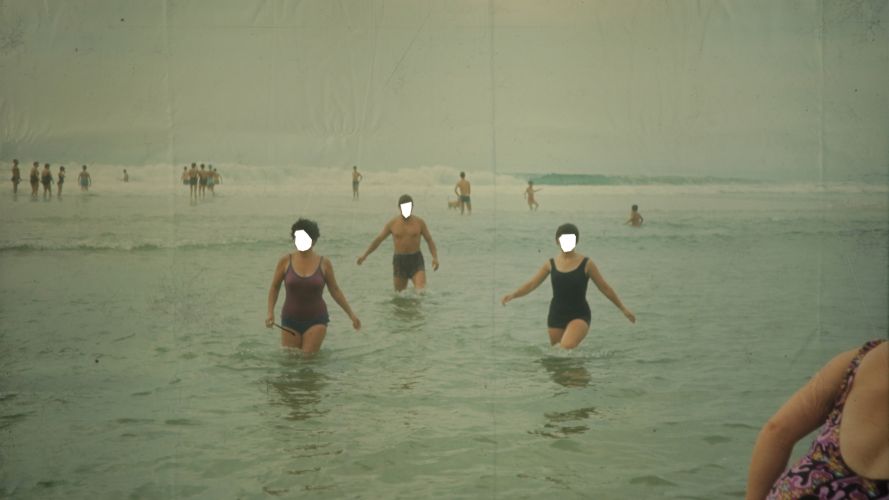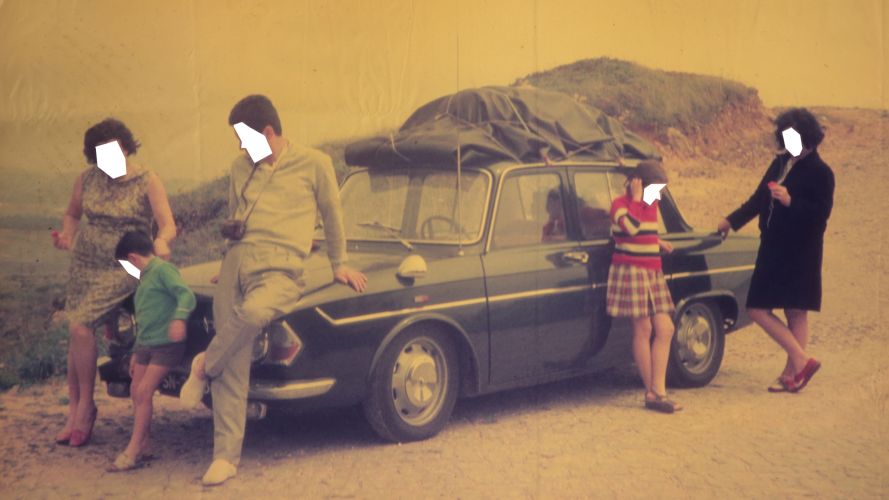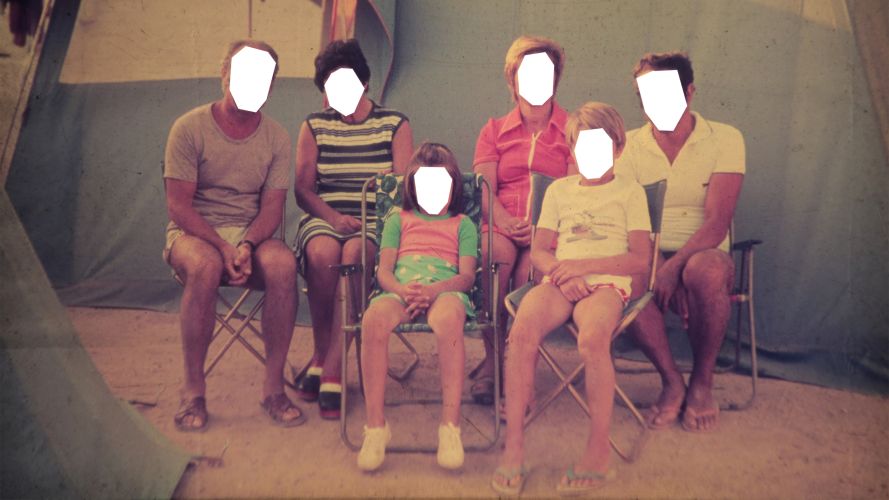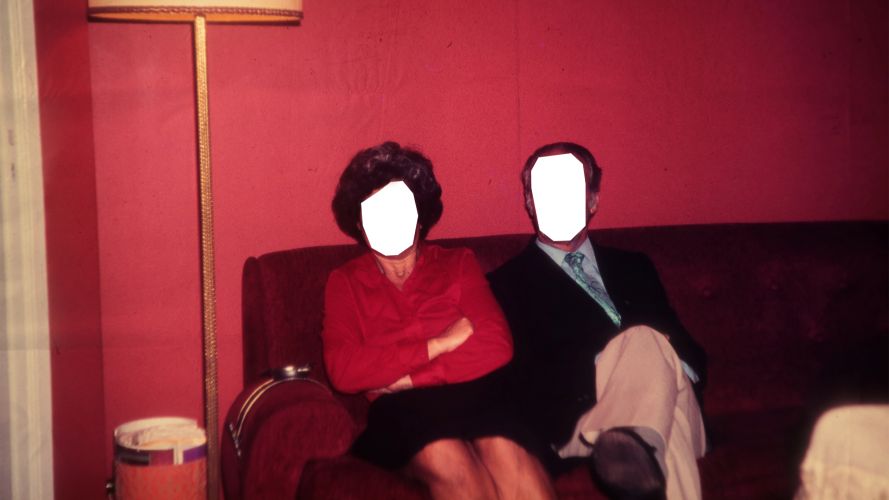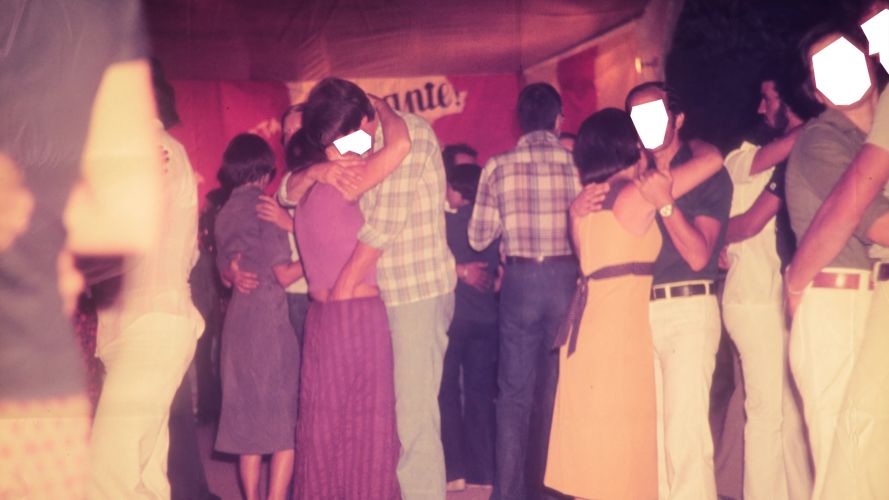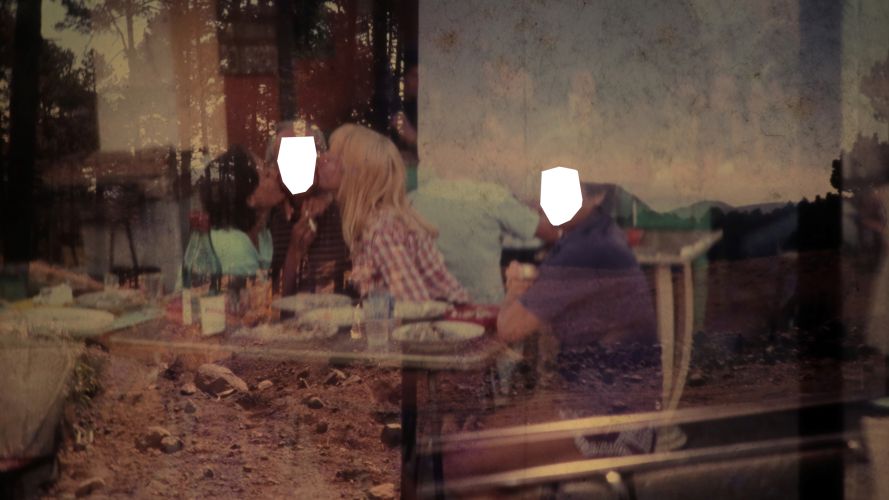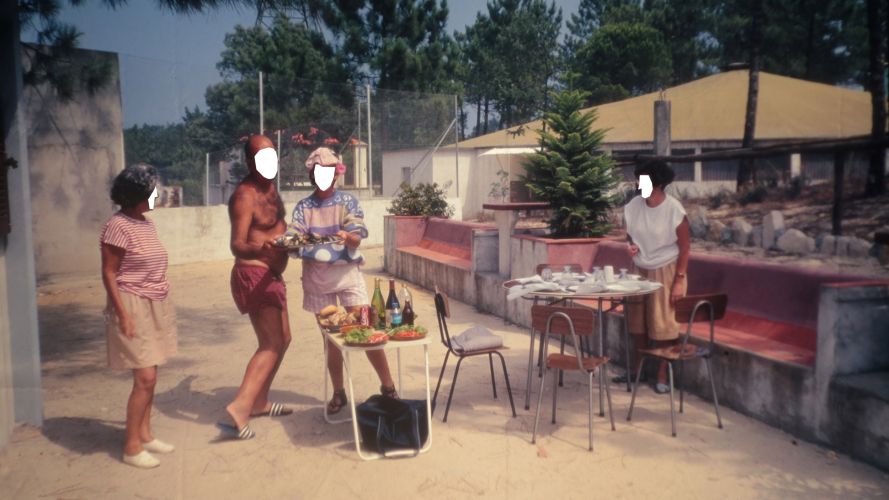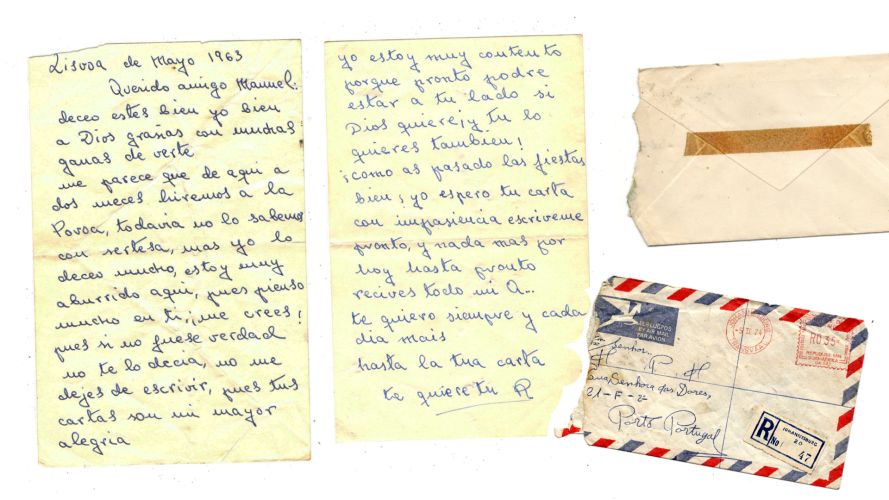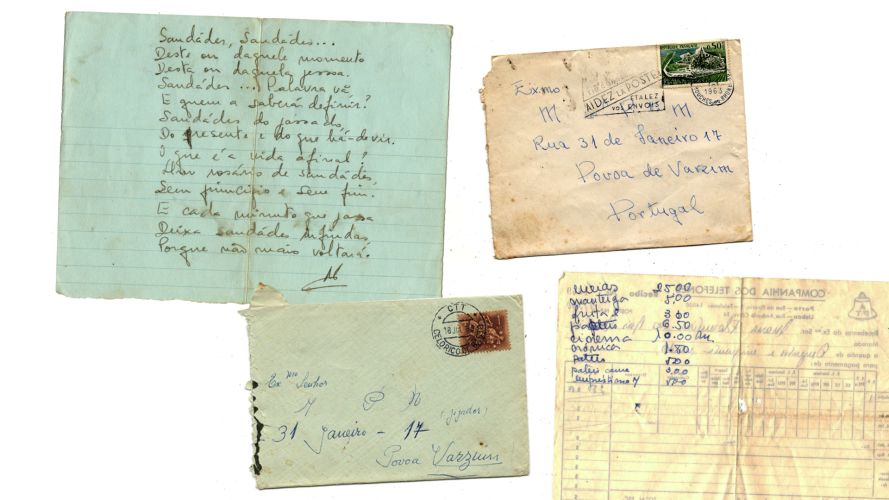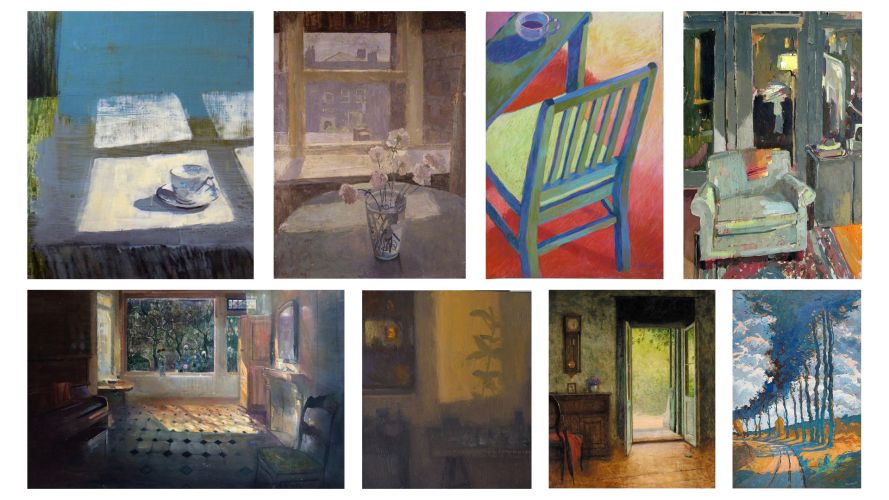10’ short animated and experimental documentary by Joana Nogueira and Patrícia Rodrigues
A partir de um conjunto de cartas de amor e de uma longa coleção de slides encontrados junto de um contentor nascem duas possíveis histórias de vida.
Numa constitui-se uma família, que cresce e se ajusta a uma timeline que reconhecemos como nossa, afecta a uma memória colectiva.
A segunda fala-nos da ausência e da passagem do tempo, marcada apenas por cambiantes de luz e sombra.
From a set of love letters and a long collection of slides found next to a container, two possible life stories are born.
In one, a family is constituted, which grows and adjusts to a timeline that we recognize as ours, affects a collective memory.
The second tells us about the absence and passage of time, marked only by changes in light and shadow.
A Patrícia estava grávida quando nos deparamos com todas aquelas cartas espalhadas pelo chão, junto de um contentor do lixo. Foi instintivo, agachámo-nos e tentámos resgatar quantas pudemos da mancha de água suja que prometia apagar tudo.
Noutro canto, perfeitamente alinhadas avistamos uma pilha de caixas cinzentas com slides organizados em magazines, e uma outra, e outra ainda; um mapa de Portugal onde estão assinaladas cidades, uma mancha de humidade na borda do vestido da noiva, como uma flor do tempo, um renault 12 vermelho, um casal sentado diante de uma tenda com o colorido perfeito. E toda uma paleta de cores se reacende no pano cru que nos serve de tela de visionamento. Iluminam-se os rostos, formam-se risos e quase ouvimos o mar.
Passado algum tempo, o mundo fechou-se e os nossos passeios foram radicalmente encurtados. Quando voltamos à rua, algo nos contentores parecia ter mudado, e algo em nós. Havia mais despojos em volta, desde as mais variadas peças de mobiliário caídas em desuso e que reabilitamos para cenários de filmes, até pequenos objectos perdidos de sentido, garrafas vazias, cestos de vime, livros da Anita, pequenos eletrodomésticos avariados. Pouco a pouco, o nosso olhar foi sendo treinado a encontrar e instalou-se esta vontade de respigar “lixo” e ressignificá-lo.
Ao olhar os objectos que encontramos, subtraídos de casas onde não sobrou gente, vamos alinhando memórias, encontrando sentido para as coisas, um arranjo floral que um dia alegrou um centro de mesa, um cesto de piquenique em vime onde sobrou uma garrafa de champanhe francês que serviu para brindar um noivado, uma caixa de bolachas que os miúdos devoram à hora do lanche, na barraca de praia.
A partir deste material finíssimo e único pretendemos reescrever as histórias, ou possíveis enredos neles inscritos. O que é estimado, o que nasce, o que cresce, o que fica suspenso, uma família que se agrega, ajustando-se a um cronograma que todos reconhecemos: a história da família, história que se repete e que identificamos também como nossa, que passa pela memória colectiva. As imagens de um país, de uma época, de uma cultura. Em paralelo desenrola-se uma narrativa, em discurso directo, com base nas cartas escritas, visualmente, figurarão espaços interiores, sem presença humana.
Patrícia was pregnant when we came across all those letters scattered on the floor, next to a garbage container. It was instinctive, we crouched down and tried to rescue as many as we could from the dirty water stain that promised to erase everything.
In another corner, perfectly aligned, we saw a pile of gray boxes with slides organized in magazines, and another one, and another one; a map of Portugal where cities are marked, a damp spot on the edge of the bride’s dress, like a flower of time, a red Renault 12, a couple sitting in front of a tent with the perfect color. And a whole palette of colors is rekindled on the raw cloth that serves as a viewing screen. Faces light up, laughter forms and we can almost hear the sea.
After some time, the world closed down and our tours were radically shortened. When we got back to the street, something in the containers seemed to have changed, and something in us. There were more remains around, from the most varied pieces of furniture that had fallen into disuse and that we rehabilitated for film sets, to small objects that had lost their meaning, empty bottles, wicker baskets, Anita’s books, small broken appliances. Little by little, our gaze was trained to find and this desire to glean “garbage” and give new meaning to it was installed.
When looking at the objects we find, taken from houses where there are no people left, we align memories, finding meaning for things, a floral arrangement that once brightened a centerpiece, a wicker picnic basket where a bottle of french champagne was left that served as a toast to an engagement, a box of cookies that the kids devour at lunchtime, at the beach hut.
From this very fine and unique material we intend to rewrite the stories, or possible plots inscribed in them. What is cherished, what is born, what grows, what is suspended, a family that comes together, adjusting to a schedule that we all recognize: the history of the family, history that repeats itself and that we also identify as ours, passing through collective memory. The images of a country, an era, a culture. In parallel, a narrative unfolds, in direct speech, based on the written letters, visually, interior spaces will appear, without human presence.
Tencionamos recorrer a diferentes técnicas de animação, explorar plasticamente a assemblagem o que nos permitirá reutilizar e retrabalhar elementos recolhidos do lixo – slides, cartas, fotografias, papéis sortidos, flores, cerâmicas, mobílias.
Partindo da plasticidade dos elementos, tratados de forma analógica, e que iremos explorar a sua bidimensionalidade, recorrendo à pintura, ao recorte e colagem sobre desenhos, fotografias, linhas e outros elementos. Tendo em conta o período deste acervo, que data de 60 a 90 – pretendemos utilizar numa animação 2D materiais, texturas e elementos próprios desse tempo: papéis manuscritos, textura de cartão craft, vestígios de fita cola, padrões coloridos de toalhas de mesa e/ou de papel de parede, marcas do tempo como patines e manchas de fungos nos acabamentos.
A pintura será fluida, com pinceladas despreocupadas que transbordam e se sobrepõem às imagens, observando uma paleta de cores que contrastará com a cor das fotografias originais. O uso da pintura sobre a imagem servirá também para ocultar a identidade das pessoas que ali figuram. A estética própria de livros de artista servirá de base de inspiração para a criação destas pinturas metafóricas e ilustrativas dos momentos relatados no documentário, assim como alguns trabalhos de mail art irão suportar a construção da plasticidade das imagens.
Para a ilustração da história das cartas pretendemos recorrer à pintura sobre vidro, com um tom expressionista que realce o espaço interior e denuncie o vazio; a luz e sombra que o trespassam, lembrando a implacabilidade do tempo. Aliado à plasticidade visual, pretende-se tratar o áudio como elemento narrativo central, realçando a ausência física, ao usar o relato dirigido a alguém que não está lá. Ouvir o que foi escrito numa carta que nos fala de solidão, de alguém que reclama resposta, enquanto ouvimos lá fora o som da chuva, compõem esse ambiente sonoro, revelando um estado de melancolia e de tristeza. Num momento em que a carta descreve ‘um dia atarefado no trabalho devido à grande quantidade de estrangeiros’, o ambiente será completado pelo som de pessoas que conversam e o de loiça a bater, transportando o espectador para um ambiente de restaurante ou de hotel, ou para um lugar de férias relatado por quem lá trabalha.
O uso de múltiplas técnicas de animação permite-nos criar vários patamares narrativos, e conjugados com o som permitem-nos oscilar expressivamente entre diferentes realidades e experiências emocionais.
A escolha de técnicas manuais de animação suporta-se na nossa experiência profissional e desejo pessoal em explorar novos métodos plásticos. Sendo que há a necessidade de compreender o seu potencial estético, aliado à vontade de explorar novas abordagens, tipologias e formas de aplicação de materiais.
We intend to use to different animation techniques, to plastically explore the assembly, which will allow us to reuse and rework elements collected from the trash-slides, letters, photographs, assorted papers, flowers, ceramics, furniture.
Starting from the plasticity of the elements, treated analogically, and that we will explore their two-dimensionality, resorting to painting, cutting and collage on drawings, photographs, lines and other elements. Taking into account the period of this collection, which dates from the 60s to the 90s – we intend to use materials, textures and elements typical of that time in a 2D animation: handwritten paper, craft card texture, traces of adhesive tape, colorful patterns on tablecloths and/ or wallpaper, signs of time such as patines and fungus stains on the finishes.
The painting will be fluid, with carefree brushstrokes that overflow and overlap the images, observing a color palette that will contrast with the color of the original photographs. The use of painting over the image will also serve to hide the identity of the people who appear there. The aesthetics of artists’ books will serve as a basis for inspiration for the creation of these metaphorical and illustrative paintings of the moments reported in the documentary, as well as some mail art works that will support the construction of the plasticity of the images.
To illustrate the history of the letters, we intend to resort to painting on glass, with an expressionist tone that enhances the interior space and denounces the void; the light and shadow that pierce it, reminding you of the implacability of time. Allied to visual plasticity, the intention is to treat the audio as a central narrative element, highlighting the physical absence, by using the report directed at someone who is not there. Hearing what was written in a letter that speaks of loneliness, of someone who demands an answer, while listening to the sound of rain outside, compose this sound environment, revealing a state of melancholy and sadness. At a time when the letter describes ‘a busy day at work due to the large number of foreigners’, the atmosphere will be completed by the sound of people talking and the sound of dishes being knocked, transporting the viewer to a restaurant or hotel environment, or to a vacation spot reported by those who work there.
The use of multiple animation techniques allows us to create several narrative levels and, combined with sound, they will allow us to oscillate expressively between different realities and emotional experiences.
The choice of manual animation techniques is based on our professional experience and personal desire to explore new plastic methods, since there is a need to understand its aesthetic potential, combined with the willingness to explore new approaches, typologies and ways of applying materials.
Budget: 160.000,00 €
Secured financing: 19.500,00 € ( financial support by ICA)




